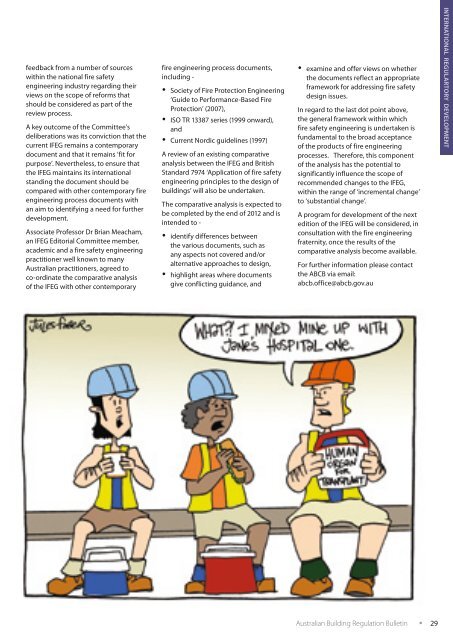PDF | 9 MB - Australian Building Codes Board
PDF | 9 MB - Australian Building Codes Board
PDF | 9 MB - Australian Building Codes Board
You also want an ePaper? Increase the reach of your titles
YUMPU automatically turns print PDFs into web optimized ePapers that Google loves.
feedback from a number of sources<br />
within the national fire safety<br />
engineering industry regarding their<br />
views on the scope of reforms that<br />
should be considered as part of the<br />
review process.<br />
A key outcome of the Committee’s<br />
deliberations was its conviction that the<br />
current IFEG remains a contemporary<br />
document and that it remains ‘fit for<br />
purpose’. Nevertheless, to ensure that<br />
the IFEG maintains its international<br />
standing the document should be<br />
compared with other contemporary fire<br />
engineering process documents with<br />
an aim to identifying a need for further<br />
development.<br />
Associate Professor Dr Brian Meacham,<br />
an IFEG Editorial Committee member,<br />
academic and a fire safety engineering<br />
practitioner well known to many<br />
<strong>Australian</strong> practitioners, agreed to<br />
co-ordinate the comparative analysis<br />
of the IFEG with other contemporary<br />
fire engineering process documents,<br />
including -<br />
• Society of Fire Protection Engineering<br />
‘Guide to Performance-Based Fire<br />
Protection’ (2007),<br />
• ISO TR 13387 series (1999 onward),<br />
and<br />
• Current Nordic guidelines (1997)<br />
A review of an existing comparative<br />
analysis between the IFEG and British<br />
Standard 7974 ‘Application of fire safety<br />
engineering principles to the design of<br />
buildings’ will also be undertaken.<br />
The comparative analysis is expected to<br />
be completed by the end of 2012 and is<br />
intended to -<br />
• identify differences between<br />
the various documents, such as<br />
any aspects not covered and/or<br />
alternative approaches to design,<br />
• highlight areas where documents<br />
give conflicting guidance, and<br />
• examine and offer views on whether<br />
the documents reflect an appropriate<br />
framework for addressing fire safety<br />
design issues.<br />
In regard to the last dot point above,<br />
the general framework within which<br />
fire safety engineering is undertaken is<br />
fundamental to the broad acceptance<br />
of the products of fire engineering<br />
processes. Therefore, this component<br />
of the analysis has the potential to<br />
significantly influence the scope of<br />
recommended changes to the IFEG,<br />
within the range of ‘incremental change’<br />
to ‘substantial change’.<br />
A program for development of the next<br />
edition of the IFEG will be considered, in<br />
consultation with the fire engineering<br />
fraternity, once the results of the<br />
comparative analysis become available.<br />
For further information please contact<br />
the ABCB via email:<br />
abcb.office@abcb.gov.au<br />
INTERNATIONAL REGULARTORY DEVELOPMENT<br />
<strong>Australian</strong> <strong>Building</strong> Regulation Bulletin<br />
• 29
















